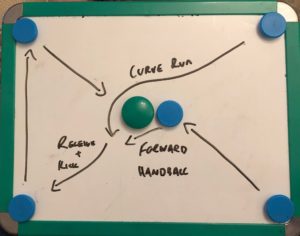The more bridges you can find to connect training idea's the better for your players ability to learn, retain and consolidate whatever tactic/strategies you're trying to implement on game day.
Usually it's the designated play against no one like cone to cone drills that have players run through the perfect example of that play over and over again, of which will happen probably once during the season if you're lucky!
Then we usually go directly to game conditions where the play breaks down as we haven't trained this play against opposition yet and players are unable to adapt the movements of them and the ball around all the constraints that games entail.
Sometimes we add a defender or 2 into the mix but it's usually skewed too far to the offensive bias and it's doesn't provide enough game representation to really carry over to actual games, it simply makes us feel like we're making progress when we're probably not.
Here's what I think is a better middle ground option - what I've coined star defenders (I know, it sounds like an 80's Saturday morning cartoon!!).
Check out the video below...
For full access to this training activity register for a level 3 membership at https://aussierulestraining.com/membership-account/membership-levels/.













